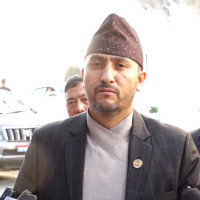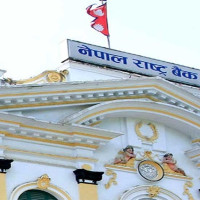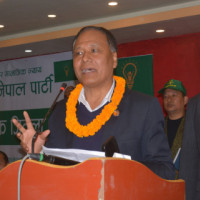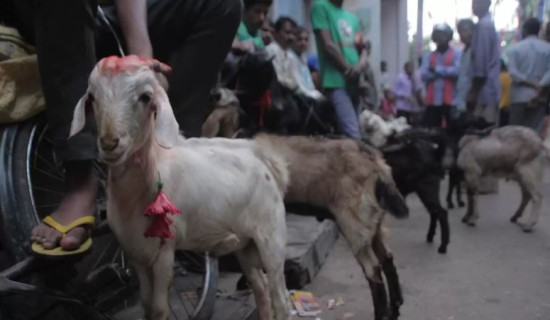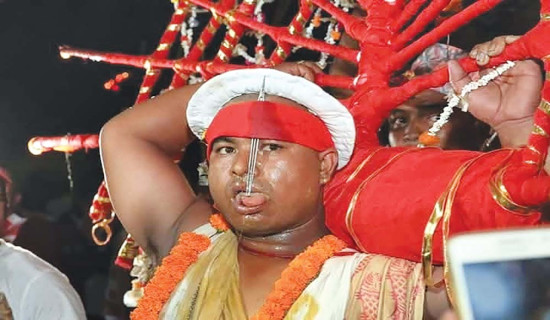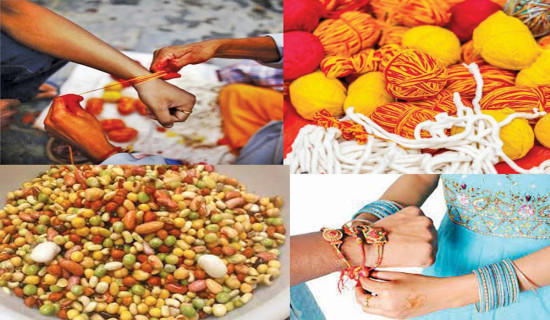- Tuesday, 16 December 2025
Kids supposed to play compelled to toil away
Kathmandu, Mar. 13: Nita, a resident of Melamchi (name changed), was forced to take up work at a small tea shop in Jorpati, Kathmandu before she was even a teenager.
When Nita was only 12 years old, her father left her mother for another woman, which made Nita and her three siblings financially helpless.
“I was only a sixth grader then,” Nita recalled. “After my father left, he stopped supporting us, not for education, not for housing, not even for food.”
The family, which did not have much to begin with, was plunged into crippling poverty. “The situation was dire,” Nita shared what drove her to work. “I decided to take up a part-time job at this tea shop to support my mother and to continue my education.”
“At the time, I had no knowledge about child labour. Nobody told me anything about it,” she said.
A runaway parent also pushed Rina (name changed) of Udayapur into underage labour. She is currently in her teens and lives in Bhaktapur. She told The Rising Nepal that her mother left her with her elder brother when she was just three years old.
A fragile economic condition forced Rina to begin working at a garment factory. “It helps us add to my father’s earnings.” But her primary reason for working at this young age is to pay for her education. “If my father had a good job, I would not have to worry about having money to buy books, pencils and school materials.”
Another girl Rita (name changed) came to Kathmandu from Dhading and entered the entertainment sector at the age of 16. She said a “brother from her village” was the “intermediary” who introduced her to the sector “but without providing information about the risks involved.”
“I faced abusive and exploitative practices in the beginning,” she informed. The three teenagers represent a larger problem of children, often from rural areas, working in different domestic and commercial settings in the cities for money.
Tara Bhandari, president of Biswas Nepal, a non-governmental organisation working to protect the rights of workers in the entertainment and hospitality sectors, informed that the economic desperation caused by the COVID-19 pandemic and the Gorkha and Jajarkot earthquakes that hit before and after it forced children from all over the country to come to Kathmandu in search of work. “And many of the children that came to the capital entered the entertainment field,” she said.
Nirmala Regmi, child welfare officer at the Tokha Municipality, Kathmandu, shared this observation. While the municipality has not kept any records of child labour, she shared that the number of migrant child labourers was high and that adult entertainment was a particularly sensitive sector.
“Our wards 9, 10 and 11 are especially sensitive because they have many restaurants, folk dance clubs (colloquially called Dohoris), guest houses, hotels and other informal establishments,” she informed.
She made sure to stress that Tokha was collaborating with various organisations to prevent child exploitation.
Gongabu, Kalanki, Thamel, Durbarmarg, Sundhara, Koteshwor and Manohara also have a bad reputation for being so-called adult entertainment hotspots in the Kathmandu Valley.
Shanta Pahadi, child welfare officer at the Kathmandu Metropolitan City (KMC), said that the metropolis also did not have records of child labour present in its area. She also said that KMC was not currently implementing any project specific to child labour.
However, the municipal council recently passed the Child Protection and Child Rights Working Procedure to address child labour. It will take effect after its publication in the local gazette.
According to 2021’s Nepal Child Labour Report, a whopping 15.3 per cent of children, that is a total of 1.1 million children, are engaged in some form of labour. It added that 3.3 per cent of child labourers in urban areas and 2.9 per cent in rural areas are involved in hazardous occupations. It also explained that underage girls (17 per cent) are more likely to be put to work than boys (14 per cent).
While a decrease from the 1.6 million children estimated to be labouring in the country in 2008, the number shows that Nepal may not fulfil the goal of eliminating 17 identified forms of child labour by 2024 it outlined in its Second National Master Plan on Child Labour for 2018 to 2028. The identified forms are domestic child labour; agricultural child labour; child porter; children used in drug peddling, trafficking and smuggling; child labour in the weaving industry; child labour in brick kilns; child labour in mines; child labour in the entertainment sector (including for sexual exploitation); child labour in transportation sector; child labour in hand embroidery; children sent to neighbouring countries for labour; children used in mechanical or chemical sectors; children used in begging; in street vending; collecting herbs; in physical infrastructure; and hotels and restaurants.
Furthermore, child welfare officers appointed by Tokha and KMC have not kept any data about child labour in their areas while other local levels of the nation do not appear to have appointed officers to such a position.
The National Child Rights Council, in its National Situation Report of Children, shows that only nine local child welfare officers have been appointed so far.
Moreover, provisions in the Child Labour (Prohibition and Regulation) Act 2000, the Labour Act 2017, the Act Relating to Children 2018 and the National Civil (Code) Act 2017 also place restrictions on the types of work children can be used in. However, child labour remains far from eliminated in the country.
Mani Ram Acharya, Programme Manager at Aasaman Nepal, an organisation develops programmes for the protection, promotion and fulfillment of child rights in Nepal, highlighted that eliminating child labour has less priority by the local, provincial and federal governments and less priority on the implementation of Master Plan on Child Labour.
The large number of child labourers shown by the child labour report of 2021 clearly shows that the three tier governments need to do a lot to make the nation child labour-free, he said.
Disintegration of the family due to parents’ substance abuse, violence or separation, health problems among one or more close relatives, natural disasters and ultimately financial troubles bring children to Kathmandu, with relatives, friends, neighbours or brokers acting as intermediaries, he said. “At the end of the day, child labour is associated with poverty.”
Acharya advised to focus on the income generation initiatives to address the family level poverty and raise awareness among parents and children to eliminate the child labour.




